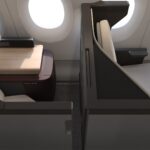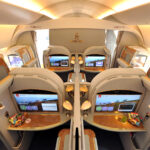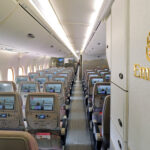Whenever you feel exhausted after a long inter-continental flight, spare a thought for those who braved long air journeys in the good old early days of aviation.
In the 1930s, seaplanes on Imperial Airways’ original ‘Kangaroo Route’ needed 12 and a half days to cover the 10,000+ miles that separate the United Kingdom from Brisbane in northern Australia.
Granted, this was not done all in one go. The limited range of airliners at the time meant that more than a dozen stopovers were required along the way, including overnight breaks. And while those in a position to fly at the time were usually people of means, the amenities were limited onboard those early, and rather primitive, cabins.
Early long-haul flyers would surely marvel at the thought of flying from Australia to the United Kingdom nonstop in under 18 hours, as Qantas does today.
Here is a practical visualization exercise to try to comprehend what we’re talking about. Imagine flying all the way from London to Los Angeles only to see your airplane turn around before landing and fly all the way back to the point of departure. This whole journey would be roughly equivalent to the duration of the longest commercial flights being operated in the world right now.
At least 10 scheduled routes are longer than 8,500 nautical miles, which means that, depending on weather conditions and routing, they can take anywhere between 15 and 19 hours.
This list is already expected to increase in 2025 as Qantas’ ‘Project Sunrise’ finally becomes a reality, linking Sydney to London and New York in one single hop.
The advent of more efficient ultra long-range aircraft, such as the Airbus A350-1000 (which Qantas selected specifically for Project Sunrise), means that other airlines might be toying with the idea of flying to ever more distant destinations.
Turkish Airlines, for example, recently announced its intention to fly to Australia before the end of 2023, although the details remain unclear, and Qatar Airways has already announced that it will be resuming its 9,000nm nonstop flight between Doha (DOH) and Auckland (AKL), New Zealand from September 2023. The route was discontinued after the outbreak of the COVID-19 pandemic.
The challenge of flying ultra-long-haul
But the increased range and new route possibilities brought about by today’s ultra-efficient airliners has come with its own set of challenges. It is not just a matter of comfort and product differentiation, but also of passenger health and wellbeing.
Spending so many hours sitting alongside a few hundred others within the confines of a sealed and pressurized metal tube with low air humidity at lower pressure than normal can be quite taxing, particularly if careful thought hasn’t been put into the design of the passenger experience.
So, it’s not surprising that some airlines operating ultra-long-haul flights have tweaked their offering to assuage their customers and make the prospect of spending almost an entire 24-hour day in the air more bearable.
Here, AeroTime takes a close look at how five airlines offering flights of longer than 15 hours are approaching the ultra-long-haul passenger experience.
Singapore Airlines
Let’s start with an airline that, as of June 2023, operates the two longest scheduled flights in the world, linking Singapore (SIN) to two different airports serving the New York City area, namely John F. Kennedy International Airport (JFK) and Newark Liberty International Airport (EWR).
The Singaporean flag carrier has been operating nonstop flights to the Big Apple since 2004, when it first launched the service with a specially configured all-business class Airbus A340-500 aircraft.
However, during these 19 years, the airline has suspended service twice for extended periods of time.
The first break came in 2013. Singapore Airlines discontinued the route alleging poor financial returns due to the high cost of operating the four-engine A340-500.
It resumed service in 2018 after having received the new more fuel-efficient twin-engine Airbus A350-800ULR, only to suspend it again for several months in 2020 due to the COVID pandemic.
This aircraft type is also deployed on Singapore Airlines third-longest route, which also makes it onto the ranking of the world’s 10 longest: Singapore Changi (SIN) to Los Angeles International (LAX).
Unlike when it was operating the A340-500, the current A350-900ULR product is not business-class only, although there is no regular economy class onboard. SIA operates with a very low-density cabin layout featuring 67 business and 94 premium economy seats.
Qantas
Geography dictates that Qantas will inevitably be a player in any ultra-long-haul flight developments.
This can be seen with the carrier’s Project Sunrise, which, come 2025, is set to dethrone Singapore to New York as the world’s longest commercial air route.
In 2022 Qantas ordered 12 A350-1000 aircraft for this flagship project, which will see Sydney and southeastern Australia linked to London and New York with a regular service for the first time.
In fact, back in 1989, Qantas flew a Boeing 747 from London to Sydney nonstop, but that was a one-off stunt that required a specially configured aircraft with only 23 people onboard.
Project Sunrise will be an extension of Qantas’ already notable ultra long-range flight portfolio. The Australian carrier already operates nonstop routes between Perth and London, Darwin and London, and Melbourne and Dallas, all of which clock in around the 18-hour mark.
So, what will the cabin look like on those extremely long Qantas flights? And what will Project Sunrise offer passengers?
Qantas has opted for a four-class cabin for 238 passengers, which, the airline claims, is the lowest density layout for this type of aircraft anywhere in the world.
It will feature six first class suites offering nearly absolute privacy, plus 52 business class suites (in a 1-2-1 configuration) as well as 40 premium economy (in a 2-4-2 layout) and 140 economy class suites (in a 3-3-3 arrangement).
When presenting the cabin for these ultra long-haul flights, Qantas has highlighted how, in addition to designers at Caon Design, it also sought out the advice of the Charles Perkins Centre, a Sydney-based medical research institution, in order to address those aspects of the ultra long-haul experience that could most heavily impact the wellbeing of passengers.
Qantas’ A350-1000 aircraft will also be fitted with a specially-designate ‘Wellbeing Zone’, where passengers of all service classes can have a stretch during the flight and get access to refreshments.
As an appetizer for the 2025 planned nonstop link, on June 14, 2023, Qantas will be launching its Sydney (SYD) to New York (JFK) flights with a stopover in Auckland (AKL), New Zealand.
Passengers on that route will receive some special treats, such as special edition pajamas designed by Rebecca Vallance and a special food selection inspired by New York City themes.
Air New Zealand
Another airline that knows a thing or two about ultra-long flights is Air New Zealand.
The Kiwi airline has been one of the most proactive carriers in devising new cabin products to help mitigate the inconvenience of ultra-long-haul flying. Strikingly, these concern all product classes, rather than just the premium segments.
Skycouch, for example, is an upgrade option that makes it possible to turn a whole row of economy class seats into a bed. The aptly named new Economy Stretch option, which became available in February 2023 on flights between Auckland and Los Angeles, offers 39% additional leg room.
But the product that has most captured the attention of the public (and the media) is the SkyNest concept, which is expected to become available on the airline’s ultra long-haul routes, such as those linking New Zealand to New York and Los Angeles, from September 2024.
Skynest consists of a number of sleeping pods resembling bunk beds, which will be available for rental by economy class passengers for several hours at a time during the flight.
This innovative bed concept will be installed onboard the new Boeing 787s that Air New Zealand is expecting to get in 2024.
The start, in 2022, of Air New Zealand’s nonstop service to New York was rocked by a series of issues that impacted the passenger experience of at least some of its passengers, though. Since the aircraft operates at the limit of its range, changing weather conditions, including unexpected headwinds and the subsequent route modifications forced the airline to leave on the ground some of the passengers and baggage on several occasions.
Emirates
The Dubai-based airline offers quite a few ultra-long routes, but, as of June 2023, the longest in its network so far is the 8,800-mile Dubai to Auckland (AKL), New Zealand, which is operated by Airbus A380-800 aircraft (although at times it the Boeing 777-200LR aircraft has also been deployed on this route).
Unlike the aforementioned carriers, Emirates doesn’t have specific cabin features on its longest flights, these are operated by aircraft with the regular cabin layout.
Emirates ultra long haul experience will likely be transformed in the near future, since in late 2022 Emirates started a major $2B refurbishment program that will see the cabin interiors of a large portion of its long-haul fleet (67 A380s and 53 Boeing 777s) go through a comprehensive revamp. The refurbishment of all 120 aircraft is expected to be completed by May 2024.
Air India
Catering to traffic between India and Silicon Valley, Air India has one flight that counts among the world’s longest.
The Bengaluru (BLR) to San Francisco (SFO) flight, operated by a Boeing 777-200LR, lasts around 17 hours, with the aircraft taking a polar route that brings it over the Himalayas, Siberia and the Arctic on its way to California
Air India offers a three-class cabin, with eight first, 35 business and 195 economy class seats onboard the Boeing 777-200LR.
Whatever we say here about the carrrier’s ultra long haul experience, though, is soon going to become updated, since Air India’s new owners, Tata Sons, have already allocated a $400 million investment package to start refurbishing the whole widebody fleet from mid-2024.
London-based agency JPA Design, a firm with experience working for the likes of Singapore Airlines and Cathay Pacific, has been appointed by Air India’s new management to work on the cabin’s comprehensive redesign.









